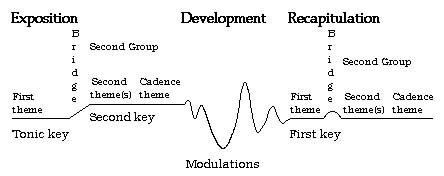Music 395—Worksheet 7
Name:
Sonata Form
Due Date: Wednesday, April 7, 2004
Readings—
-
Green, Form in Tonal Music
-
Ch. 11: The Sonata Form, pp. 178-219
-
Ch. 12: Further Aspects of Sonata Form, pp. 220-233
-
Charles Rosen, Sonata Forms (RESERVE)
-
Introduction, pp. 1-7
-
First-Movement Sonata Forms, pp. 96-104
-
Slow-Movement Sonata Forms, pp. 104-110
Return to top
Score Analysis
Beethoven, Symphony No. 5 in C minor, Op. 67: mvmt. i
Before you start, read the materials from the Green (blue?) textbook and from Rosen’s Sonata Forms (RESERVE), one of the most important books written on the subject. On pages 1 and 2, Rosen gives what he calls a “traditional” description of sonata form in four paragraphs. The main features of his description are presented below in both arch map and tonal profile diagram formats. Note that the First Theme Group may also include a literal or varied Counterstatement of Theme 1 (not shown below).
Sonata Form Arch Map

Sonata Form—Tonal Profile Diagram

Use the diagram below to guide your analysis of the first movement of Beethoven’s Symphony No. 5. Fill in the blanks to indicate the main key(s) for each section as well as the measure (M. #) where each section begins! (If a particular section seems transitional or developmental and doesn't basically stick with the same key throughout, then tell me what keys it begins and ends in.)

Now answer these questions about the first movement.
- Is there a counterstatement in the First Theme Group? If so, where (measure number)? Is it literal or varied? If varied, how is it changed?
- Are the main themes in the Exposition fairly distinct? Which two themes are most similar? Do you hear any recurring motives? Please explain your answers.
- Rosen says the Development section can begin in several ways (p. 2). Which of his options apply to the beginning of the Development in Beethoven’s 5th?
- Which themes does Beethoven use most frequently in the Development? What techniques does Beethoven use to develop them? Give examples. Are there any new themes here?
- It is often possible to divide the main part of the Development into more than one section based on texture, ideas developed, and so on. How many large sections can you find in this Development? (Sections must be real sections– not just a phrase or two!) Where do these sections begin and end. What primary key areas does Beethoven establish?
- Is the Recapitulation literally the same as the Exposition? If not, at what specific points is it different (identify with measure numbers from Recapitulation)? Describe any differences. Are these differences the ones we expect in “standard” sonata form, or are they unusual?
- Does Beethoven use any new themes in the Coda? Where? Do you hear any previously used themes in the Coda? Which ones? Where?
- Which of these words best describe this Coda: expository, transitional, developmental, and/or terminative? Why? Does Beethoven’s Coda fit your expectations of what a coda should be/do? Explain.
- Finally, looking at the entire piece, which features of this movement seem unusual? That is, which features don’t fit with the charts above or the descriptions in the books by Green or Rosen?
Return to top
Suggested Recordings—
Buehler Library RESERVE
-
MCD B415/21g—Complete Beethoven Symphonies (on the RESERVE shelf for Music 344!)
Created 4/01/04 by Mark Harbold—last updated 4/01/04.



